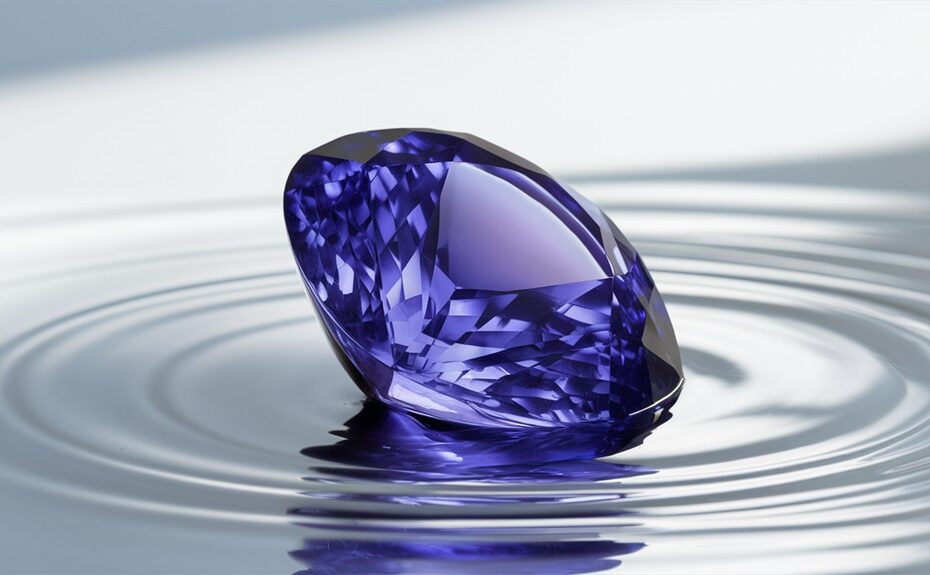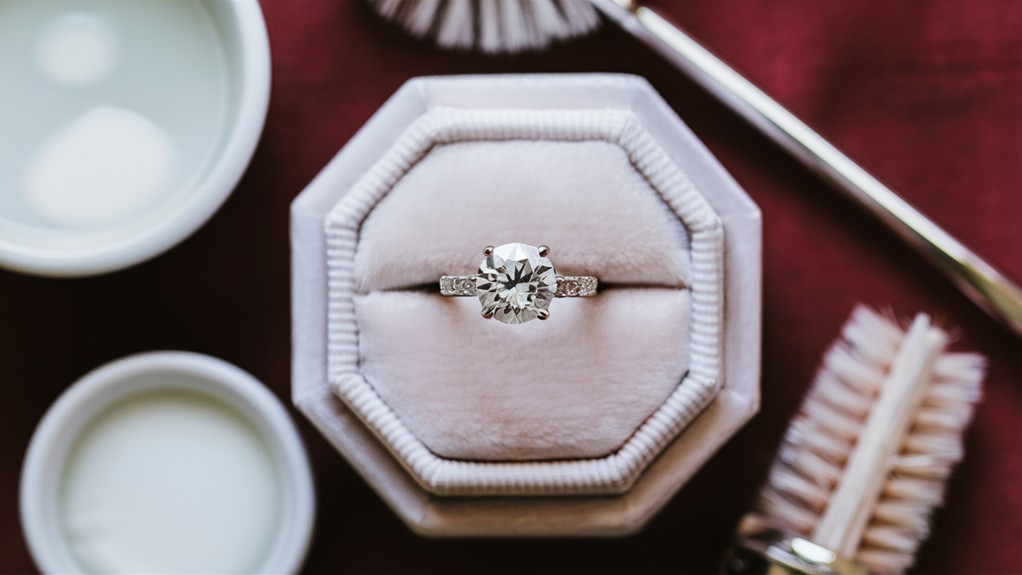You've probably admired the stunning blue-violet hues of tanzanite, but have you ever wondered about its care? This rare gemstone, found only in Tanzania, requires special attention to maintain its beauty. While it can get wet, there's more to know about cleaning and protecting your tanzanite jewelry. From safe cleaning methods to proper storage techniques, understanding how to care for this precious gem is essential. If you're a proud owner of tanzanite or considering adding it to your collection, you'll want to learn the do's and don'ts of tanzanite care to keep your gem sparkling for years to come.
Our Highlighted Points
- Tanzanite can get wet briefly for cleaning, but avoid prolonged exposure to water.
- Clean tanzanite with warm, soapy water and a soft toothbrush, then rinse and dry thoroughly.
- Avoid exposing tanzanite to harsh chemicals, especially acids, which can cause corrosion.
- Store tanzanite separately from other jewelry to prevent scratches due to its relative softness.
- Protect tanzanite from hard impacts and sudden temperature changes to maintain its integrity.
Understanding Tanzanite's Unique Properties
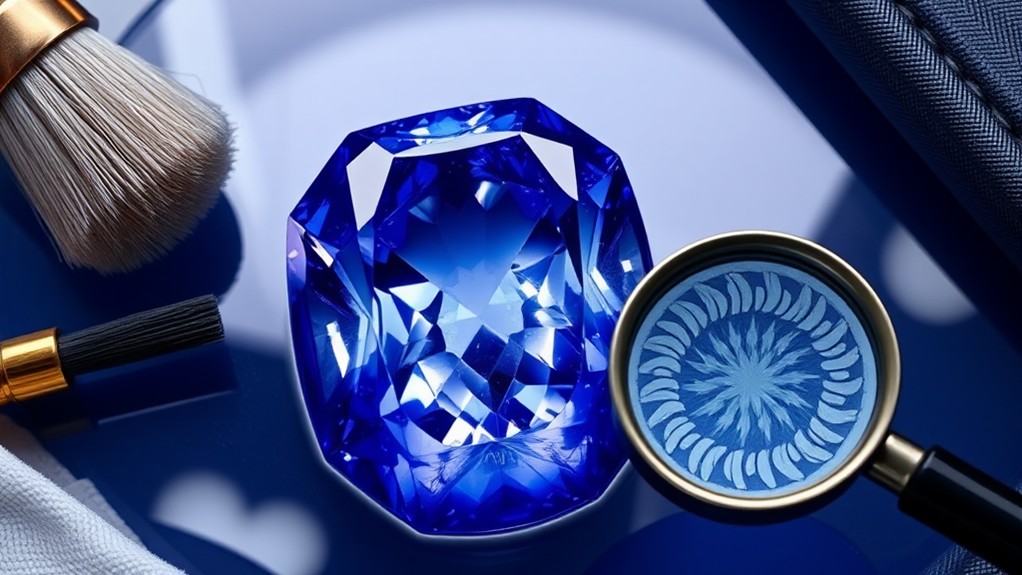
Delicacy defines tanzanite, a gem that demands special attention due to its unique properties. This enthralling blue-violet stone ranks 6-7 on the Mohs scale, making it relatively soft and susceptible to scratches and impacts. Additionally, tanzanite is also known for its pleochroism, meaning it can display different colors when viewed from different angles. This makes it crucial for tanzanite to be cut and set with precision to showcase its best color. When it comes to grading the quality of tanzanite, there can be variations in opinion, which is why an igi vs gia comparison can help buyers make an informed decision about the value and authenticity of the gem.
To guarantee your tanzanite's longevity, you'll need to understand its characteristics and implement proper care routines.
Key points to remember about tanzanite's properties:
- Cleavage: Tanzanite can break if struck sharply, requiring gentle handling.
- Heat treatment: The stone undergoes a heating process to improve its color, which doesn't affect its stability.
- Chemical sensitivity: Harsh chemicals, particularly hydrochloric acid, can corrode tanzanite.
For everyday wear and maintenance:
- Avoid exposing your tanzanite to harsh cleaning products or chemicals.
- Clean gently with warm, soapy water to prevent dullness.
- Remove tanzanite jewelry before engaging in activities that may cause impacts or scratches.
- Store separately from harder gemstones to prevent accidental damage.
Safe Cleaning Methods for Tanzanite
Your tanzanite's brilliance deserves careful maintenance. Regarding Tanzanite Care, the best way to clean this delicate gem is with warm, soapy water. This method is always safe and effective for removing dirt and grime without risking damage to the stone's structure.
To begin the cleaning process:
- Prepare a solution of warm water and mild soap.
- Gently scrub the tanzanite using a soft toothbrush, paying special care to intricate areas.
- Rinse thoroughly to remove all soap residue, which can dull the gem's appearance.
- Pat dry with a lint-free cloth.
For routine maintenance, simply polish your tanzanite with a soft, lint-free cloth to remove fingerprints and restore its luster.
Remember to take care to avoid common chemicals and harsh cleaning methods that could harm your gem.
Important: Avoid using ultrasonic or steam cleaning devices, as these can cause significant damage to tanzanite's delicate structure.
Water Exposure and Tanzanite Care
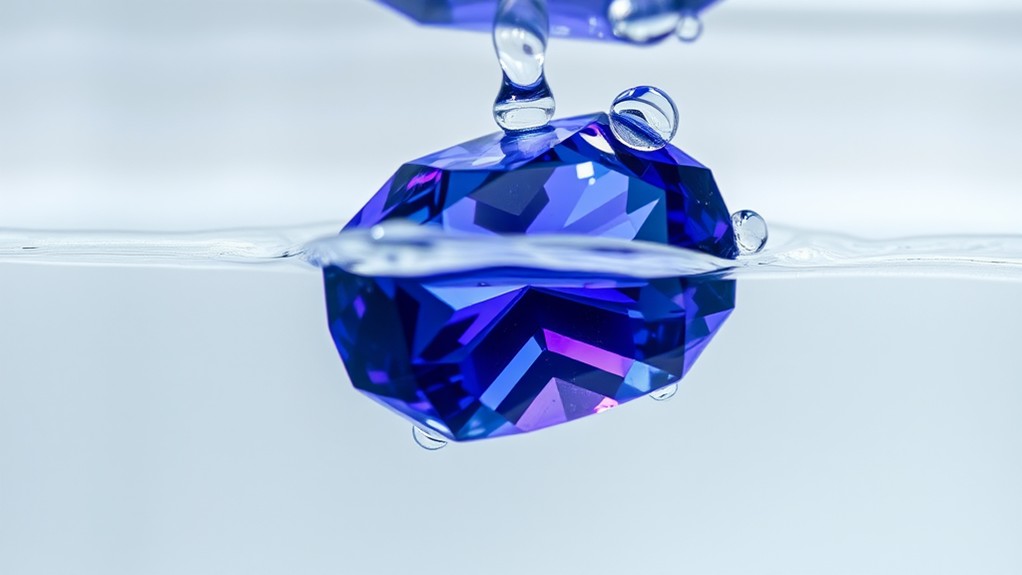
While tanzanite can withstand brief water exposure, it's best to limit contact to maintain its brilliance. When cleaning your tanzanite jewelry, use a solution of mild soap and warm water, ensuring thorough rinsing to prevent any residual film that could dull its appearance. After cleaning, dry the gemstone completely to avoid moisture-related damage and preserve its luster.
To protect your tanzanite, avoid prolonged exposure to water, especially in harsh conditions. Chlorinated water, such as in swimming pools, can potentially harm the gemstone because of its harsh chemicals. It's vital to store your tanzanite separately from other jewelry to prevent scratches and avoid direct sunlight, which can fade its color over time.
| Care Aspect | Do | Don't |
|---|---|---|
| Cleaning | Use mild soap and warm water | Use ultrasonic and steam cleaners |
| Water Exposure | Brief contact for cleaning | Prolonged exposure, especially to chlorinated water |
| Storage | Store separately in a soft cloth | Keep with other jewelry or in direct sunlight |
| Maintenance | Consult a reputable jeweler regularly | Attempt repairs on fracture-filled stones yourself |
| General Care | Handle with clean, dry hands | Expose to harsh chemicals or extreme temperatures |
Protecting Tanzanite From Damage
Protecting tanzanite from damage requires careful handling and awareness of its vulnerabilities. As a relatively soft gemstone with a Mohs hardness of 6-7, tanzanite is susceptible to scratches and damage. To maintain its beauty:
- Avoid exposure to harsh chemicals, especially acids like hydrochloric acid.
- Clean tanzanite using warm, soapy water and a soft toothbrush. Soapy water is always the safest option for cleaning.
- Take care to store tanzanite jewelry separately in soft pouches or lined boxes to prevent scratches from harder gemstones.
- Avoid hard impacts and sudden temperature changes, which can cause stress fractures.
When wearing tanzanite:
- Remove jewelry before engaging in activities that may subject it to impacts or abrasion.
- Be cautious of loose tanzanite stones in settings; have them checked regularly by a jeweler.
For professional care:
- Schedule regular inspections with a reputable jeweler to monitor the condition of your tanzanite.
- If scratches occur, consult a reputable lapidary for potential re-polishing options.
Storing and Maintaining Tanzanite Jewelry
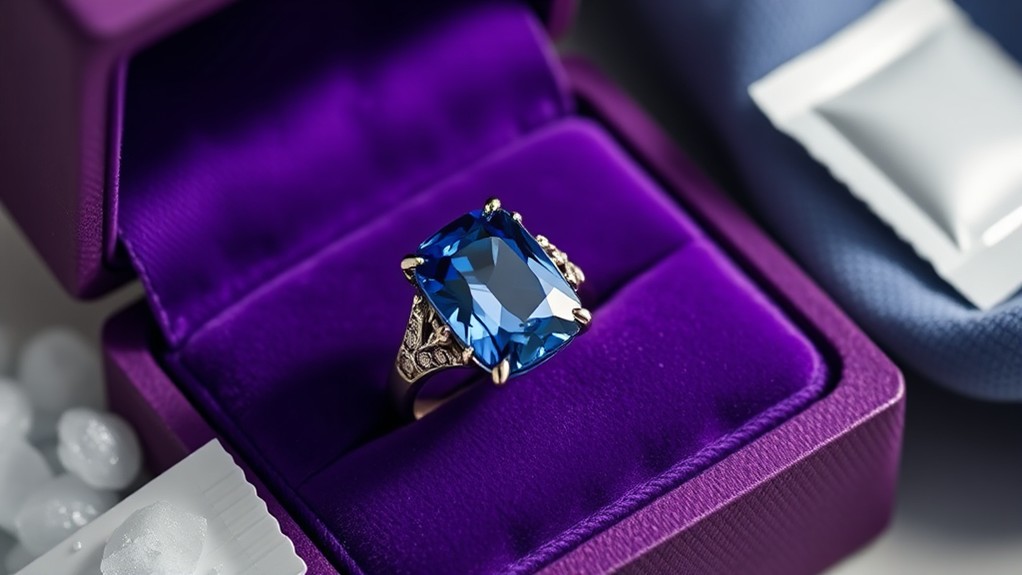
For tanzanite jewelry to retain its beauty and value, proper storage and maintenance are vital. Store your tanzanite pieces separately in soft pouches or lined boxes to prevent abrasion from harder gemstones. This precaution is important, as tanzanite ranks 6-7 on the Mohs scale, making it susceptible to scratches.
Maintain a cool, dry environment for tanzanite storage, avoiding direct sunlight to prevent potential color fading. Regularly inspect your storage conditions for signs of wear or damage to guarantee the integrity of your tanzanite jewelry is preserved.
When cleaning your tanzanite pieces, use warm, soapy water and a soft cloth, making sure they're completely dry before storing to prevent moisture-related damage.
To properly maintain your tanzanite jewelry, follow these key steps:
- Store pieces individually in soft pouches or lined boxes
- Keep tanzanite in a cool, dry environment away from direct sunlight
- Regularly inspect storage conditions for signs of wear or damage
- Clean with warm, soapy water and a soft cloth, drying thoroughly before storage
Frequently Asked Questions
Can You Get Tanzanite Wet?
Yes, you can get tanzanite wet. It's safe for brief exposure to water, like when washing your hands. However, you shouldn't soak it for long periods. Always dry it thoroughly after it gets wet to maintain its beauty.
Can Tanzanite Be Worn in the Shower?
You shouldn't wear tanzanite in the shower. It's a soft gemstone that can be damaged by water, soaps, and chemicals. To protect its beauty and integrity, it's best to remove tanzanite jewelry before showering or any water-related activities.
Can You Put Tanzanite in Water?
You can briefly put tanzanite in water for cleaning, but don't submerge it for long periods. Use warm, soapy water, rinse thoroughly, and dry completely. Avoid prolonged exposure to moisture as it can damage this delicate gemstone.
What Can Damage Tanzanite?
You'll damage tanzanite if you expose it to harsh chemicals, sudden temperature changes, or hard impacts. It's easily scratched by harder materials and can break because of cleavage. Moisture can dull its appearance if not dried properly.
